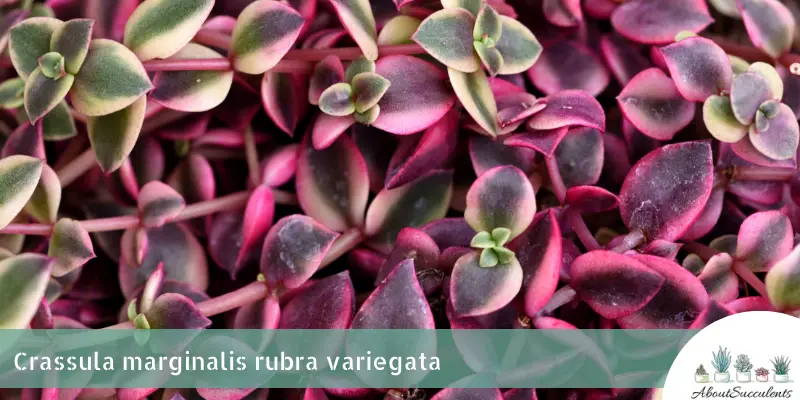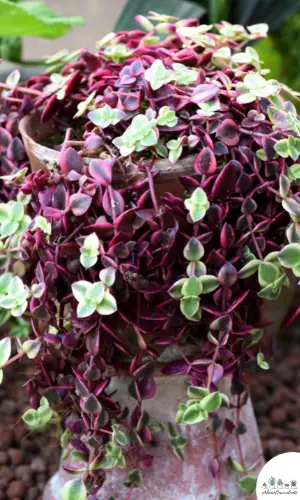
Crassula Marginalis Rubra Variegata is the perfect succulent for those who love sharing and engaging in social media.
Also known as Calico Kitten or Calico Kitten Crassula, its alluring appeal, wow-inducing colors, and enchanting appearance will certainly have more of your followers engage you with likes, comments, and shares.
How gorgeous is Calico Kitten?
Let’s start with its heart-shaped leaves which feature a mesmerizing combination of purple, pink, various shades of green, yellow, and some hints of cream for good measure.
When properly cared for, the leaves will take on a more dominant purple to fuschia color. Calico Kitten Crassula’s spectacular color mix makes it the ideal succulent in hanging baskets.
A fully-matured Crassula can reach a height of 8cm (3”) with a width of 30.5cm (12”). Calico Kitten is native to South Africa and is a member of the Crassulaceae family.
General Information
Also known as: Calico Kitten, Calico Kitten Crassula
Plant Family: Crassulaceae
Origin: South Africa
Height: 8cm (3”)
Exposure: Grows well when exposed to full or partial sun for up to 6 hours.
Water Needs: Water using the soak and dry method where the soil has to be completely dried out before giving it a thorough soaking.
Soil Type: 2:1 ratio of cactus mix to perlite or coarse sand. Another option is a 1:1:1 ratio of cactus mix, perlite, and coarse sand.
Soil pH: 6.1 to 6.5
How to Grow and Care for Crassula Marginalis Rubra Variegata
Crassula Marginalis Rubra Variegata is an easy type of succulent to grow and care for.
As you will read, Calico Kitten Crassula doesn’t require much fussing over. The succulent’s growth requirements are simple and easy to do.
It’s very important to keep in mind that Crassula cannot tolerate frost for a long time.
If the temperature in your region drops below -6.7° C (20° F), then it would be best to plant Calico Kitten in a pot that you can transfer indoors when conditions become frosty.
Sunlight
This variety of Crassula thrives in full to partial sunlight. We recommend partial sunlight because Calico Kitten’s leaves are sensitive and might burn if exposed to the full rays of the sun for a long time.
Choose a location in your garden where Calico Kitten Crassula can get up to 6 hours of morning or late afternoon sunlight every day.
As a houseplant, place the pot near a window that welcomes 6 hours of partial sunlight per day.
Watering

Watering Crassula Marginalis Rubra Variegata is where succulent growers make mistakes.
Yes, as a plant, Crassula needs water. But as a succulent plant, Calico Kitten stores water in its leaves and stems. It will not require as much water as other varieties of plants.
Watering the soil when it hasn’t dried out completely will mean disaster for your beautiful Crassula. The roots will rot and leave the plant exposed to a fungal infection.
Always check the moisture level of the soil. You can do this simply by inserting a stick into the soil. If the stick comes out dry, the soil is ready to receive water.
The second mistake succulent growers make is watering from above. Always water the soil and not the plant. As we mentioned earlier, Crassula stores water in its leaves and stems.
Pot and Soil
As you just read, overwatering is bad for Crassula. You must make sure moisture leaves the soil within 7 to 10 days or the roots will rot.
Choose a pot that’s made of ceramic or terracotta material because they allow moisture to escape from the soil. The pot that you buy for Calico Kitten Crassula must have drain holes at the bottom to enable excess water to run out.
Cactus mix is the best choice for Crassula because it drains fast and is well-aerated. Add perlite or coarse sand at a ratio of 2:1 to soil. You can also use both perlite and coarse sand with a ratio of 1:1:1 to cactus soil.
How to Propagate Crassula Marginalis Rubra Variegata
Propagating Crassula Marginalis Rubra Variegata is easy and there are 3 ways to go about it.
Method 1 – Offsets
Step 1: Pull out or cut the small offsets that have grown at the base of the main plant.
Step 2: Place the offsets in a warm area and give it 1 to 2 days to dry out. You will see calluses on the offsets which means they’re ready to be planted.
Step 3: Plant the dried-out offsets in well-draining cactus soil.
Step 4: Water the soil when it has completely dried out.
Method 2 – Leaves
Step 1: Cut off a healthy leaf with a sterilized pair of garden shears. You can also perform a twist and pull but make sure no part of the leaf is left on the stem to guarantee successful propagation.
Step 2: Let the leaves dry out in a warm area for 2 to 3 days. During this time, the leaves will grow calluses.
Step 3: Place the callused leaves on a pot filled with cactus mix.
Step 4: Keep the soil lightly moistened until you see the roots begin to sprout.
Step 5: Water the soil only when it has dried out when the roots have taken a firm hold.
Method 3 – Stem Cuttings
Step 1: Choose a healthy stem and cut it with a sterilized knife or garden scissors.
Step 2: Allow the stem to develop calluses by letting it dry out in a warm area for 2 to 3 days.
Step 3: Lightly mist the soil with water until the roots have formed.
Step 4: When you see the roots fully formed, only water the soil once you have tested its level of dryness.
Frequently Asked Questions
Is Crassula Marginalis Rubra Variegata Toxic to Cats and Dogs?
Crassula Marginalis Rubra Variegata is generally safe for cats and dogs as it is not listed on the website of the American Society for the Prevention of Cruelty to Animals (ASPCA) as a succulent plant that’s toxic for animals.
Why Is My Crassula Marginalis Rubra Variegata Dying?
Does Crassula Marginalis Rubra Variegata seem lifeless to you? Is it getting weaker every day?
There are 2 primary causes of death for Calico Kitten: overwatering and pest infestation. If you catch the symptoms of these causes right away, you can save your precious plant.
Overwatering
Crassulas, like other types of succulent plants, can survive for a long time without water. If you give them water before the soil has dried out, the succulent might not have long to live.
Overwatering succulents do more bad than good. It will cause the roots to get filled out with water and result in the cells rupturing. When this happens, the plant becomes exposed to the risk of infection.
A fungus can easily make its way into your plant through the ruptured roots. The disease will manifest itself by appearing as black spots on the plant. You might also notice the leaves or the stems turning into an unhealthy blackish color.
At this point, you must act right away and cut off the discolored sections with a sterilized knife or garden shears.
Uproot the plant and cut out all the roots that have rotted. While you let Calico Kitten Crassula dry out, prepare a new pot with a fresh cactus mix, perlite, or coarse sand where the succulent will soon call home.
Pest Infestation
Insects love Calico Kitten because it’s easy to drain the sap from its tender leaves. The worst offenders are mealybugs and aphids.
You can’t see them because they’re so tiny. Signs that these pests are in your plant are if you see the leaves topped with white, powder-like substances.
First, wipe off the substances with a cotton ball soaked in 70% isopropyl alcohol. Don’t use a stronger type of alcohol because it will burn the leaves of the plant.
From there, spray the plant with neem oil or water mixed with 70% isopropyl alcohol to get rid of the pests.
There are other problems you might experience while growing and caring for Calico Kitten Crassula. These problems are not deadly but can still potentially harm the succulent.
The first one is not giving it enough water. You’ll know that this is the case if the leaves look shriveled and feel deflated. Crassula can survive without water for weeks because it stores water in its leaves and stems. But once the water runs out, the leaves will become flat.
The second problem is sunburn which happens when the succulent is given too much exposure to direct sunlight. The leaves will turn dark brown when they’re sunburned. When you notice this, cut off the sunburned leaves right away.
The last problem is etiolation which occurs when the plant doesn’t receive enough sunlight. The leaves will extend and reach out as if in search of the rays of the sun. If you see the leaves looking thin and withered out, simply give it a bit more sun exposure.
Yes, Crassula Marginalis Rubra Variegata produces small, star-shaped, and white-colored flowers during the end of spring and toward the start of summer.
Last Updated on June 9, 2022 by Sofia Lara